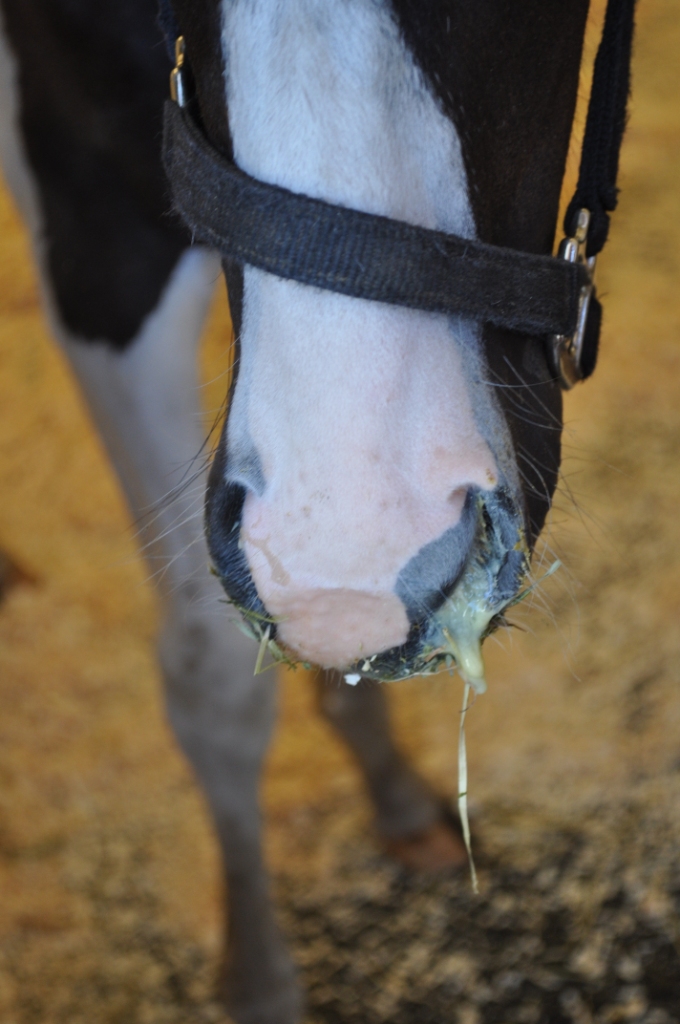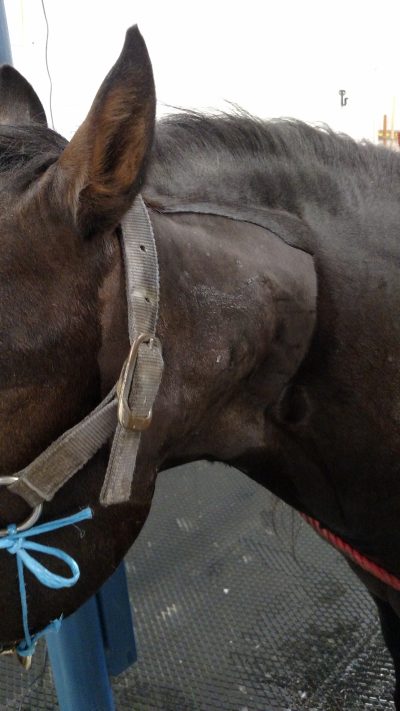Sally DeNotta, DVM, PhD, DACVIM, UF College of Veterinary Medicine

Figure 1: Mucopurulent nasal discharge in a horse with strangles. Credit: DeNotta, UF College of Veterinary Medicine
There has been a recent uptick in the number of horses affected by the disease commonly known as ‘Strangles’ in Florida. Horse owners need to be extra vigilant with disease prevention and biosecurity measures while traveling or competing with their horses. Strangles is a disease caused by bacterial infection with Streptococcus equi subspecies equi (also referred to as S. equi). Strangles is highly contagious in horse populations and can cause outbreaks when an infected horse is introduced into a new group or herd. It is also commonly transmitted at large gatherings of horses, such as at show grounds or competition venues.
The name strangles originated from infected horses that occasionally suffocated from enlarged, infected lymph nodes obstructing their upper airway or trachea. The hallmark clinical signs of S. equi infection are fever (temperature >101.5ºF), mucopurulent (thick and opaque) nasal discharge (Figure 1 right), and enlarged lymph nodes (can be palpated in the throatlatch and/or space between the lower jaw bones) (Figure 2 below). These enlarged lymph nodes eventually become abscesses that can rupture either externally through the skin, or internally into the guttural pouches and then out the nose. Many infected horses will also have a reduced appetite, depression, and difficulty swallowing.
Clinical signs alone are often enough to make a diagnosis of strangles. However, definitive diagnosis is made by culture of the bacteria from a sample of purulent discharge (from the nose or guttural pouch), a lymph node abscess, or a nasal-pharyngeal wash. Another available test, polymerase chain reaction (PCR), is very sensitive test that detects bacterial DNA. PCR cannot tell the difference between live and dead bacteria, and is typically used in conjunction with culture.

Figure 2: Enlarged lymph nodes in a horse with strangles. Credit: DeNotta, UF College of Veterinary Medicine
Most horses with strangles will resolve with only supportive care with anti-inflammatories and pain relievers. In these horses, antibiotics may actually prolong the duration of disease and are therefore contraindicated (not an advised treatment). Strangles cases with complications, or those requiring tracheostomy for management of respiratory distress, generally do require antibiotic and other more intensive supportive therapies. Antibiotics may also be used during a strangles outbreak when early identification of horses with fever and subsequent antibiotic treatment can actually prevent them from ever developing clinical strangles.
The first and most important thing to remember in a case of strangles is to contact your veterinarian right away to determine a plan for diagnosis and treatment, as well as the best control practices for your particular farm. Strangles is a reportable disease in Florida, and the state veterinarian will assist with the isolation and quarantine process to prevent further spread outside of the property. Movement of any horses on or off the farm should be stopped, and new horses should not be introduced. All horses on the property should have their temperatures taken and recorded twice daily. Normal rectal temperature is 99-101.5°F. Monitoring the rectal temperature and isolating horses at the first sign of fever is one of the most effective ways to stop the spread of infection. Infected horses can transmit the bacteria to healthy horses 1-2 days after they develop a fever.
–
Key ways to prevent strangles in your horses and barn:
–
-
When traveling to shows, minimize your horse’s exposure by bringing your own feed, buckets, and equipment. Minimize use of shared stalls or pastures at show grounds.
–
-
Don’t allow your horse to contact or co-mingle with any unknown horses while showing or traveling.
–
-
All horses should have individual water buckets that are routinely disinfected.
–
-
Require a current health certificate for new horse arrivals on the farm.
–
-
Ask owners of new horses about a history of strangles and consider testing new horses to see if they are shedding the bacteria.
–
-
Quarantine new arrivals on the farm for 2-3 weeks and monitor their temperature.
–
In summary, reducing your horse’s exposure to unknown horses and practicing good biosecurity at show grounds will decrease the chance of infection with strangles. If your horse or farm is involved in a strangles outbreak, work with your veterinarian to isolate affected horses and create an infection control plan.
- Livestock Owners are Encouraged to be on the Lookout for New World Screwworm in the Wake of Outbreaks in Central America - March 21, 2025
- Horse Feed and Cattle Feed Don’t Mix: 70 Horses Die After Ingesting Feed Contaminated with Monensin - September 6, 2024
- Don’t Let Your Horse Get Stricken by Strangles - March 8, 2024
